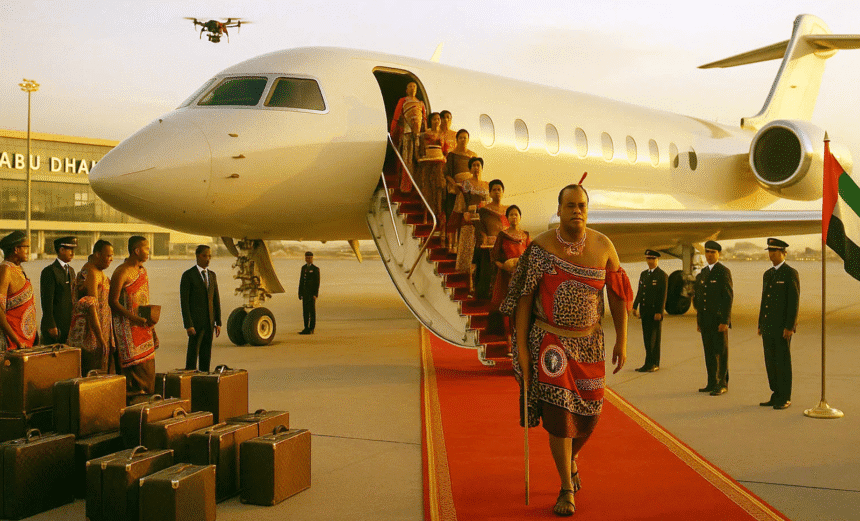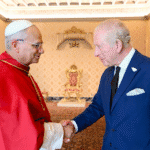The arrival of King Mswati III, the ruler of Eswatini, in Abu Dhabi has created a global stir after footage surfaced showing the monarch landing in the UAE with 15 wives, 30 children, and over 100 servants. The king’s lavish entrance aboard a private jet drew widespread attention and sparked heated debate about royal extravagance, leadership, and inequality in the small southern African kingdom. The video, originally recorded in 2022 but resurfacing online in mid-2025, shows the royal procession descending from the aircraft in striking traditional attire as aides and attendants managed dozens of suitcases and security personnel cleared the tarmac. Airport officials in Abu Dhabi reportedly closed off several terminals to accommodate the massive entourage.
King Mswati III has ruled Eswatini, formerly known as Swaziland, since 1986, making him one of the world’s last absolute monarchs. Unlike constitutional monarchies, his power extends over nearly all areas of governance, from the appointment of officials to control of the nation’s economy and traditional structures. Eswatini, despite its rich cultural heritage, remains one of the poorest countries in the region, with an estimated 60 percent of its population living below the poverty line. This stark contrast between the king’s opulence and his people’s hardship has long fueled controversy. Analysts estimate the monarch’s personal fortune at more than USD 1 billion, with investments spanning telecommunications, real estate, and agriculture.
According to diplomatic sources, the purpose of the visit was to strengthen economic and investment relations between Eswatini and the United Arab Emirates. Meetings were reportedly planned to explore partnerships in trade, tourism, and renewable energy. Abu Dhabi’s leadership, headed by President Sheikh Mohamed bin Zayed Al Nahyan and Crown Prince Sheikh Khaled bin Mohamed Al Nahyan, welcomed the visit as part of their ongoing diplomatic outreach to African nations. Yet, critics argue that the royal spectacle overshadowed any substantive diplomatic message. What was intended as a state visit for cooperation has instead become a viral sensation, highlighting the vast divide between monarchy and modern governance.
The king’s entourage, made up of 15 of his 30 wives and about 30 of his more than 70 children, added a theatrical element to the event. The wives, dressed in coordinated traditional Swazi and contemporary outfits, walked behind the king as dozens of attendants carried gifts and personal belongings. The visual grandeur was meant to showcase Swazi royal pride and culture, but quickly drew global attention online. Social media users from Africa to the Middle East criticized the lavish display, questioning how a ruler whose people struggle with unemployment and lack of basic amenities could justify such extravagance. One viral comment read, “While his people live without electricity or clean water, their king lands with an army of servants.”
Within Eswatini, the episode has reignited debates over the monarchy’s relevance in a modern, democratic world. Pro-democracy activists have long accused the king of prioritizing royal luxury over national welfare, citing continued economic stagnation and high youth unemployment. International observers say the viral Abu Dhabi footage is symbolic of the broader challenges facing traditional monarchies in Africa, how to balance cultural preservation with the demands of transparency, equality, and modernization. For many Swazis, the video represents not just spectacle but a painful reminder of economic disparity.
In Abu Dhabi, however, the event reinforced the city’s image as a global hub for diplomacy and high-profile state visits. The UAE’s own political system, a federal monarchy, is built on stability and centralized governance, making it a natural host for royal diplomacy. While the official details of King Mswati’s meetings remain undisclosed, sources suggest the talks included potential Emirati investments in Eswatini’s infrastructure and tourism sectors. Nonetheless, for global audiences, the enduring image is not of boardroom negotiations but of a desert runway crowded with royal splendor, an extraordinary display of power, privilege, and pageantry in a world increasingly uncomfortable with such extremes.
The viral moment has cemented King Mswati III’s reputation as one of the most flamboyant monarchs of the modern era. Whether the visit ultimately delivers tangible benefits for Eswatini or remains a symbol of royal excess will depend on the months to come. For now, the world remains divided between admiration for the cultural spectacle and outrage over its moral implications.

















